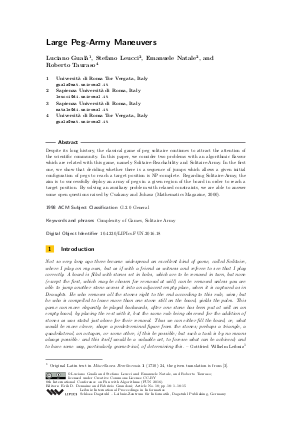Large Peg-Army Maneuvers
Authors Luciano Gualà, Stefano Leucci, Emanuele Natale, Roberto Tauraso
-
Part of:
Volume:
8th International Conference on Fun with Algorithms (FUN 2016)
Part of: Series: Leibniz International Proceedings in Informatics (LIPIcs)
Part of: Conference: International Conference on Fun with Algorithms (FUN) - License:
 Creative Commons Attribution 3.0 Unported license
Creative Commons Attribution 3.0 Unported license
- Publication Date: 2016-06-02
File

PDF
LIPIcs.FUN.2016.18.pdf
- Filesize: 0.65 MB
- 15 pages
Document Identifiers
Subject Classification
Keywords
- Complexity of Games
- Solitaire Army
Metrics
- Access Statistics
-
Total Accesses (updated on a weekly basis)
0Document
0Metadata
Abstract
Despite its long history, the classical game of peg solitaire continues to attract the attention of the scientific community. In this paper, we consider two problems with an algorithmic flavour which are related with this game, namely Solitaire-Reachability and Solitaire-Army. In the first one, we show that deciding whether there is a sequence of jumps which allows a given initial configuration of pegs to reach a target position is NP-complete. Regarding Solitaire-Army, the aim is to successfully deploy an army of pegs in a given region of the board in order to reach a target position. By solving an auxiliary problem with relaxed constraints, we are able to answer some open questions raised by Csakany and Juhasz (Mathematics Magazine, 2000).
Cite As Get BibTex
Luciano Gualà, Stefano Leucci, Emanuele Natale, and Roberto Tauraso. Large Peg-Army Maneuvers. In 8th International Conference on Fun with Algorithms (FUN 2016). Leibniz International Proceedings in Informatics (LIPIcs), Volume 49, pp. 18:1-18:15, Schloss Dagstuhl – Leibniz-Zentrum für Informatik (2016)
https://doi.org/10.4230/LIPIcs.FUN.2016.18
BibTex
@InProceedings{guala_et_al:LIPIcs.FUN.2016.18,
author = {Gual\`{a}, Luciano and Leucci, Stefano and Natale, Emanuele and Tauraso, Roberto},
title = {{Large Peg-Army Maneuvers}},
booktitle = {8th International Conference on Fun with Algorithms (FUN 2016)},
pages = {18:1--18:15},
series = {Leibniz International Proceedings in Informatics (LIPIcs)},
ISBN = {978-3-95977-005-7},
ISSN = {1868-8969},
year = {2016},
volume = {49},
editor = {Demaine, Erik D. and Grandoni, Fabrizio},
publisher = {Schloss Dagstuhl -- Leibniz-Zentrum f{\"u}r Informatik},
address = {Dagstuhl, Germany},
URL = {https://drops.dagstuhl.de/entities/document/10.4230/LIPIcs.FUN.2016.18},
URN = {urn:nbn:de:0030-drops-58709},
doi = {10.4230/LIPIcs.FUN.2016.18},
annote = {Keywords: Complexity of Games, Solitaire Army}
}
Author Details
References
-
M. Aigner. Moving into the Desert with Fibonacci. Math. Magazine, 70(1):11-21, 1997.

-
G. Aloupis, E. D. Demaine, A. Guo, and G. Viglietta. Classic Nintendo games are (computationally) hard. Theoretical Computer Science, 586:135-160, 2015.

-
J. D. Beasley. The Ins and Outs of Peg Solitaire. Oxford University Press, 1985.

-
J. D. Beasley. Solitaire: Recent Developments. arXiv:0811.0851, 2008.

- J. D. Beasley. John and Sue Beasley’s Webpage on Peg Solitaire, 2015. URL: http://jsbeasley.co.uk/pegsol.htm.
-
G. I. Bell. A Fresh Look at Peg Solitaire. Mathe.Magazine, 80(1):16-28, 2007.

-
G. I. Bell, D. S. Hirschberg, and P. Guerrero-Garcia. The minimum size required of a solitaire army. arXiv/0612612, 2006.

-
E. R. Berlekamp, J. H. Conway, and R. K. Guy. Winning Ways for Your Mathematical Plays, Volume 2. AK Peters, 2002.

-
A. Bialostocki. An application of elementary group theory to central solitaire. The College Mathematics Journal, 29(3):208, 1998.

-
F. Chung, R. Graham, J. Morrison, and A. Odlyzko. Pebbling a Chessboard. The American Mathematical Monthly, 102(2):113-123, 1995.

-
B. Csakany and R. Juhasz. The Solitaire Army Reinspected. Math. Magazine, 73(5):354-362, 2000.

- E. W. Dijkstra. The checkers problem told to me by M.O. Rabin, 1992. URL: http://www.cs.utexas.edu/users/EWD/ewd11xx/EWD1134.PDF.
- E. W. Dijkstra. Only a matter of style?, 1995. URL: http://www.cs.utexas.edu/users/EWD/ewd12xx/EWD1200.PDF.
-
M. Gardner. The Unexpected Hanging and Other Mathematical Diversions. University of Chicago Press, 1991.

-
L. Guala, S. Leucci, and E. Natale. Bejeweled, Candy Crush and other match-three games are (NP-)hard. In CIG 2014, pages 1-8, 2014.

-
R. A. Hearn and E. D. Demaine. Games, puzzles, and computation. AK Peters, 2009.

-
R. Honsberger. A problem in checker jumping. Mathematical Gems II, pages 23-28, 1976.

-
C. Jefferson, A. Miguel, I. Miguel, and S. A. Tarim. Modelling and solving English Peg Solitaire. Computers &Operations Research, 33(10):2935-2959, 2006.

-
M. Kiyomi and T. Matsui. Integer Programming Based Algorithms for Peg Solitaire Problems. In Computers and Games, number 2063 in LNCS, pages 229-240. Springer, 2000.

-
C. Moore and D. Eppstein. One-Dimensional Peg Solitaire, and Duotaire. arXiv/0008172, 2000.

-
B. Ravikvmar. Peg-solitaire, string rewriting systems and finite automata. In Algorithms and Computation, volume 1350, pages 233-242. Springer, 1997.

-
R. Uehara and S. Iwata. Generalized Hi-Q is NP-Complete. IEICE TRANSACTIONS, E73-E(2):270-273, 1990.

